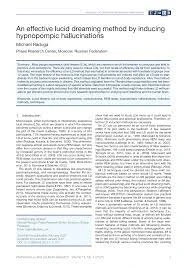As we close our eyes and drift off into slumber, our minds create a world of their own, transporting us to surreal and fantastical settings. What if you could take control of these dreams and become the master of your own subconscious mind? That’s where the concept of lucid dreaming comes in. It’s a curious phenomenon that has captivated the minds of people for centuries. In this article, we’ll explore what lucid dreaming is, its benefits, and most importantly, ten tips to help you increase your likelihood of experiencing this mystical state. So, let’s delve into the world of dreams and learn how to harness their power.
What is a Lucid Dream?

A lucid dream is a type of dream where the dreamer becomes aware that they are dreaming. In this state, the dreamer has a sense of control over their dream, which can lead to some incredible experiences.
Definition
Lucid dreaming is a state of consciousness where the dreamer knows they are dreaming and can control their actions in the dream. It is a unique experience where a person can actively participate in their dreams and even manipulate them to some extent. Lucid dreaming can be an extremely vivid and realistic experience, sometimes feeling more real than our waking reality.
Benefits
Lucid dreaming can have a wide range of benefits, both psychologically and creatively. It can help improve problem-solving skills and increase confidence, as well as providing a fun and exciting escape. It can also be used for therapeutic purposes, such as facing fears or working through emotional issues. With the ability to control and manipulate the dream, it can lead to some incredible and unique experiences that are impossible in waking life.
Lucid dreaming is a fascinating phenomenon that can have a positive impact on our lives. Whether it’s for entertainment, creative purposes, or personal growth, the ability to enter a state of lucidity during sleep opens up a whole new world of possibilities for exploration and self-discovery.
Definition
Lucid dreaming refers to the state of being aware that one is dreaming while being in the midst of a dream. A person who is experiencing a lucid dream is able to consciously control and manipulate their dream environment, as if they were a director of their own movie. This can include changing the setting, interacting with dream characters, or exploring the limits of their imagination. In a lucid dream, the dreamer is not limited by the laws of physics or reality, and can do anything that they imagine. This type of dream is unique because the person is able to actively participate in and shape the experience. While lucid dreaming may occur spontaneously, it can also be learned and developed through the practice of various techniques and tools.
Benefits
Lucid dreaming has several benefits that make it a worthwhile pursuit. One of the main benefits is the ability to take control of your dreams and experience things that you may not be able to in waking life. This could include traveling to different parts of the world, meeting people you may never have the opportunity to meet, or even flying through the air.
Another benefit is the potential for personal growth and self-improvement. Lucid dreaming can help increase self-awareness and introspection, allowing you to uncover deeper aspects of your psyche and work through unresolved issues. This can lead to emotional healing and greater clarity in waking life.
Lucid dreaming has also been linked to improved problem-solving skills, enhanced creativity, and increased confidence. By practicing lucid dreaming, you may find that you are more adept at finding solutions to real-life problems and have a more positive outlook on life.
Lucid dreaming has been shown to improve sleep quality and reduce nightmares, leading to a better overall sense of well-being. By turning dreams from chaotic and frightening experiences to controlled and positive ones, you can enjoy a more restful sleep and wake up feeling refreshed.
The benefits of lucid dreaming are numerous and wide-ranging, making it a valuable practice for anyone interested in personal growth and exploration of their inner world.
Tip #1: Keep a Dream Journal

One of the most important tips for increasing your chances of having a lucid dream is keeping a dream journal. This may seem like a simple task, but it can be incredibly effective in helping you achieve your lucid dreaming goals.
Why Keep a Dream Journal
Keeping a dream journal is essential for several reasons. Firstly, it helps you remember your dreams. Many people forget their dreams shortly after waking up, and if you can’t remember your dreams, you have little chance of becoming lucid in them. Secondly, a dream journal allows you to identify dream signs, which are recurring patterns or themes in your dreams. By identifying these dream signs, you can increase your chances of becoming lucid when you encounter them in future dreams.
How to Keep a Dream Journal
Keeping a dream journal is simple, but it does require some dedication. Start by placing a journal or notebook beside your bed, along with a pen or pencil. As soon as you wake up, try to remember as much of your dream as possible and write it down in your journal. Be sure to record as many details as you can, including any feelings, sensations or emotions you experienced during the dream.
It’s essential to write in your dream journal every morning, even if you can’t remember any dreams from the night before. Over time, this practice will help you to remember more of your dreams and will make it much easier to identify recurring dream signs. You might even notice patterns in your dreams that you were previously unaware of.
Keeping a dream journal is a simple yet effective way to boost your chances of having a lucid dream, and it’s an excellent starting point for anyone new to lucid dreaming. Make it a daily habit to record your dreams as soon as you wake up, and you’ll soon start to notice a difference in the vividness and frequency of your dreams.
Why Keep a Dream Journal
It might sound strange at first, but keeping a dream journal can actually increase your chances of having a lucid dream. This is because in order to have a lucid dream, you need to first become more aware of your regular dreams. Keeping a detailed record of your dreams can help you recognize patterns and themes, as well as identify recurring dream elements.
But why is this important? By becoming more aware of your dreams, you can start to question whether you are actually dreaming while you’re in the dream state. This is because many of us go through life on autopilot, simply accepting whatever is happening around us as reality, even when we’re dreaming. But if you’re actively analyzing your dreams and looking for commonalities, you’ll start to notice things that seem out of place or unusual – this is what can trigger the realization that you’re dreaming.
Additionally, keeping a dream journal helps you remember your dreams better. It’s all too easy to wake up in the morning and forget what you dreamed about the night before. However, if you make a habit of writing down your dreams every morning, you’ll be training your brain to remember them. And the more you remember, the more data you have to work with in terms of analyzing your dreams and looking for patterns that might help you have a lucid dream.
Keeping a dream journal is an essential part of increasing your chances of having a lucid dream. It helps you become more aware of your dreams and remember them better, both of which are important factors in achieving lucidity.
How to Keep a Dream Journal
One of the most important tips for increasing your chances of having a lucid dream is keeping a dream journal. Dream journals are an incredibly useful tool for improving dream recall and identifying common dream themes or symbols. Here’s how you can start keeping a dream journal:
1. Keep the Journal Near Your Bed: It’s essential to keep the journal and a pen or pencil within arm’s reach of your bed. That way, you can write down your dream as soon as you wake up and before it fades from memory.
2. Record Your Dreams as Soon as You Wake Up: As soon as you wake up, grab your journal and record your dream in as much detail as possible. Write down everything you can remember, including any emotions, sounds, colors, and people or objects that appeared in the dream.
3. Write in the Present Tense: When describing your dream, write it in the present tense. This technique can help you remember more details about the dream and make it feel more vivid.
4. Use Drawings or Diagrams: If you’re a visual learner, consider drawing pictures or diagrams of your dreams. This technique can help you visualize the dream and remember it more clearly.
5. Review Your Journal Regularly: Review your dream journal regularly to identify any common themes or symbols. This information can help you become more aware of the patterns in your dreams and increase your chances of having a lucid dream.
By keeping a dream journal, you’ll become more in tune with your dreams and improve your ability to remember them. Over time, you may start to notice patterns in your dreams or recurring symbols that you can use to trigger lucidity.
Tip #2: Reality Checks

Reality Checks to Increase Your Chances of Lucid Dreaming
Reality checks are a popular technique used by people who want to increase their chances of having a lucid dream. A reality check is simply a test you perform to determine whether you are dreaming or not.
Why Do Reality Checks
The purpose of reality checks is to help you distinguish between the waking reality and the dream world. By practicing reality checks during your waking hours, you will train your brain to ask the same question in your dreams.
This technique can help you realize that you are dreaming, which can lead to a lucid dream. Once you become aware that you are in a dream, you can take control of the dream and do whatever you want.
Examples of Reality Checks
There are many different reality checks you can try. Some popular ones include:
1. Pinching your nose and trying to breathe through it. If you can breathe through your nose while it is pinched, you are dreaming.
2. Looking at a clock or watch twice. If the time has changed dramatically in between looks, you are dreaming.
3. Trying to push your finger through the palm of your other hand. If it goes through, you are dreaming.
4. Jumping up and down. If you float or begin to fly, you are dreaming.
5. Checking your reflection in a mirror. If your reflection is distorted or looks different than expected, you are dreaming.
It’s important to choose a reality check that works for you and to practice it consistently throughout the day. This will help make it a habit and increase the chances of performing the test in your dream.
Remember, the goal of reality checks is to train your brain to question whether you are dreaming or not. With practice, you can master this technique and increase your chances of experiencing a lucid dream.
Why Do Reality Checks
One of the most effective tips for increasing your chances of having a lucid dream is to perform reality checks throughout the day. Reality checks serve as a way to distinguish whether you are dreaming or not. This is important because it allows you to identify a dream and then potentially gain control over it. Without the ability to distinguish reality from a dream, you may believe that the events taking place within your dream are real and not subject to your control.
The primary point of reality checks is to question your surroundings and question the state of your consciousness. Often, reality checks will reveal inconsistencies that are present in a dream but not in waking life. This can allow you to trigger lucidity and take control of the dream. While reality checks can take many different forms, the key is to find a few that work for you and to perform them regularly throughout the day. With persistence and practice, you can train your brain to habitually perform reality checks, increasing your chances of triggering lucidity during your dreams.
Examples of Reality Checks
Reality checks are an essential part of increasing your chances of having a lucid dream. These checks help you determine whether you are in a dream or reality. Here are some examples of reality checks you can practice:
1. Finger Counting: Check whether you have the right number of fingers on your hand or if they look distorted. In a dream, fingers tend to look wobbly or not symmetrical.
2. Time Check: Look at a clock, and then look away. Look back again, and check if the time changed in an illogical way. In a dream, clocks often show impossible times or change erratically.
3. Reading: Look at a written text, look away, and then look back again. In a dream, the text may appear different or distorted when you check it again.
4. Jump Test: Try to jump, and check if you float or fly. In a dream, gravity doesn’t work as it does in reality.
5. Nose Test: Try to breathe through your blocked nose. In a dream, you can breathe even when your nose is blocked.
Remember to do these reality checks regularly throughout the day. Eventually, they will become a habit, and you’ll automatically do them in your dreams. That way, you’ll be more likely to realize that you’re dreaming and be able to take control of your dream.
Tip #3: Set Your Intention

Setting your intention is a critical step when it comes to having lucid dreams. Your intention is like a mental goal that you set for yourself before going to sleep. When you set your intention, you are telling your mind that you want to have a lucid dream. This helps put your subconscious mind in the right state to increase your chances of having a lucid dream.
How to Set Your Intention: To set your intention, you need to start by focusing on the desired outcome. Imagine yourself becoming lucid in your dreams, and visualize what it feels like to have complete control over your dream world. Affirmations can also be helpful. Repeating a positive statement like “I will have a lucid dream tonight” or “I am in control of my dreams” can help reinforce your intention and increase the likelihood of having a lucid dream.
It’s important to note that setting your intention is not a one-time event. Make it a habit to set your intention every night before going to sleep. This helps to establish a routine and reinforces the idea in your mind that you want to have a lucid dream.
It’s also important to keep a positive mindset. Believe that you can have a lucid dream and focus on the possibilities instead of the obstacles. Trust your abilities and your subconscious mind to help you achieve your goal. Remember that lucid dreaming is a skill that takes practice, so don’t get discouraged if you don’t have a lucid dream right away.
Setting your intention is a powerful tool for increasing your chances of having a lucid dream. By focusing your mind on the desired outcome and making it a habit, you can train your brain to help you achieve your goal. So, take the time to set your intention every night and have fun exploring the depths of your subconscious mind in your lucid dreams.
How to Set Your Intention
Setting your intention is a powerful technique that can greatly increase your chances of having a lucid dream. The idea is to remind yourself, before going to bed, that you want to have a lucid dream.
Step 1: Start by writing down your intention. Be specific and use positive language. For example, “I will have a lucid dream tonight and I will realize that I am dreaming.”
Step 2: Repeat your intention out loud several times, with conviction. This will help to reinforce the message in your subconscious mind.
Step 3: Visualize yourself having a lucid dream. Imagine what it will feel like to realize that you are dreaming and be in control of the dream.
Step 4: Focus on your intention as you fall asleep. Keep repeating it to yourself and try to maintain a clear, positive mindset.
Step 5: Upon waking up, try to recall your dreams and whether or not you had a lucid dream. If you did not have a lucid dream, repeat the process the next night.
Remember, setting your intention is not a guarantee that you will have a lucid dream, but it is a powerful tool to increase your chances. Combine it with other techniques like reality checks and wake-back-to-bed for the best results. With persistence and practice, you can train your mind to become aware during your dreams and unlock the incredible world of lucid dreaming.
Tip #4: Meditation

Meditation is another technique that can have a positive impact on your ability to have lucid dreams. It can help calm your mind and improve your overall attention and awareness, which are essential for having lucid dreams. Meditation can also help you recognize your own thoughts and emotions, making it easier to identify when you are in a dream state.
Why Meditation Helps
Meditation can help you clear your mind of distractions, which is essential for being able to focus on your dream world. When you meditate, you are training your brain to be more focused and aware. This increased focus and awareness can help you recognize when you are dreaming and can also help you stay in the dream state once you realize that you are dreaming.
How to Meditate for Lucid Dreaming
To meditate for lucid dreaming, find a quiet place where you can sit or lie down comfortably. Close your eyes and focus on your breathing. Try to clear your mind of all thoughts and allow yourself to become completely relaxed. You can use a guided meditation or simply listen to calming music to help you relax.
Once you have achieved a state of relaxation, you can start visualizing yourself in a dream state. Imagine yourself becoming aware that you are dreaming and imagine yourself exploring your dream world. Try to make your visualization as vivid as possible, using all of your senses to create a realistic dream experience.
Repeat this meditation practice regularly to improve your ability to have lucid dreams. Regular meditation can help improve your focus and awareness, making it easier to recognize when you are dreaming and allowing you to stay in the dream state for longer periods of time.
Why Meditation Helps
Meditation is a powerful tool that can aid in lucid dreaming. By meditating, you are essentially training your brain to become more aware and focused, which can be incredibly helpful in achieving lucid dreams. Meditation may also help to reduce stress and anxiety which are often barriers to good quality sleep and can also make it harder to achieve lucidity in dreaming. By meditating, you are also training your mind to be more conscious and mindful both while awake and asleep. This increased mindfulness and awareness can help you to better recognize when you are dreaming and facilitate the transition to lucidity.
Meditation also helps to improve overall sleep quality, which can indirectly help with lucid dreaming. When you meditate, you are often in a deep state of relaxation, which can help to reduce the amount of time it takes for you to fall asleep. This deeper sleep has been linked to more vivid and memorable dreams, making it easier to remember your dreams and become lucid while sleeping. Additionally, by improving the quality of your sleep through meditation, you may be more likely to reach the REM stage of sleep, which is where most lucid dreams occur.
The benefits of meditation for lucid dreaming cannot be overstated. Through regular practice, meditation can help you to improve your overall awareness, reduce stress and anxiety, improve sleep quality and facilitate the transition to lucid dreaming. By incorporating meditation into your daily routine, you will be taking an important step towards achieving your goal of having lucid dreams.
How to Meditate for Lucid Dreaming
Meditation is a powerful tool for improving focus and reducing stress, both of which can help increase your chances of having a lucid dream. You don’t need to be an experienced meditator to incorporate meditation into your lucid dreaming practice. Here are some steps to get started:
1. Find a quiet, comfortable place to meditate. This should be a place where you won’t be disturbed, with minimal noise and distractions. Sit in a comfortable position, with your back straight and your hands resting on your lap.
2. Focus on your breath. Close your eyes and take a few deep breaths, slowing down your breathing rate. Then, allow your breath to continue at its natural pace. Pay attention to the sensation of the air moving in and out of your body, and notice any thoughts that arise without engaging with them.
3. Visualize your dream. Once you feel relaxed and focused, visualize yourself in a dream landscape. Use your imagination to create a vivid image in your mind, and see yourself becoming aware that you are dreaming.
4. Repeat a mantra. You can also incorporate a mantra into your meditation practice to help focus your intention on having a lucid dream. For example, you could repeat to yourself “I will have a lucid dream tonight” or “I am aware that I am dreaming.”
5. Practice regularly. Meditation is a skill that requires practice and consistency. Aim to meditate for at least 10-15 minutes each day, gradually increasing the length of your sessions over time.
By incorporating meditation into your lucid dreaming practice, you can develop greater focus, relaxation, and intentionality, all of which can improve your chances of having a lucid dream. Give it a try and see how it affects your dreams!
Tip #5: Wake-Back-to-Bed Technique

One popular technique for increasing your chances of having a lucid dream is the Wake-Back-to-Bed (WBTB) technique. This technique involves waking up in the middle of the night and then going back to sleep with the intention of having a lucid dream.
What is the Wake-Back-to-Bed Technique?
The WBTB technique involves setting an alarm for about six hours after you go to bed. When the alarm goes off, get out of bed and stay awake for about 15-30 minutes. During this time, engage in quiet activities like reading or meditating. The idea behind this technique is that it helps to increase awareness and stimulate brain activity, which can increase your chances of having a lucid dream when you go back to sleep.
To get started with the WBTB technique, set your alarm for six hours after you go to bed. When the alarm goes off, get out of bed and do something quiet, such as reading or meditating. Avoid using bright lights or technology during this time, as these can stimulate the brain and make it harder to fall back asleep. After 15-30 minutes, go back to bed with the intention of having a lucid dream.
It’s important to note that the WBTB technique can be a bit disruptive to your sleep schedule, so it’s best to use it sparingly. It’s also a good idea to experiment with the timing of the technique to find what works best for you. Some people may find that waking up a bit earlier or later works better for them.
The Wake-Back-to-Bed technique can be an effective way to increase your chances of having a lucid dream. By interrupting your sleep cycle and boosting brain activity, it can help to increase awareness and make it easier to achieve lucidity when you go back to sleep.
What is the Wake-Back-to-Bed Technique
The Wake-Back-to-Bed (WBTB) technique is a lucid dreaming strategy that involves waking up in the middle of the night, staying awake for a short period of time, then going back to sleep with the intention of having a lucid dream. This technique takes advantage of the fact that most lucid dreams occur during the Rapid Eye Movement (REM) stage of sleep, which happens after a few hours of sleeping. By waking up and returning to sleep during the REM period, the chances of having a lucid dream increase significantly.
How to Use the Wake-Back-to-Bed Technique
To use the WBTB technique, set an alarm for approximately 4-6 hours after the time you typically fall asleep. When the alarm goes off, get out of bed and stay awake for 30 minutes to an hour. During this time, you may choose to read about lucid dreaming, meditate, or engage in another quiet activity that keeps your mind alert but not overstimulated.
After the designated time has passed, return to bed with the intention of lucid dreaming. Focus on the fact that you want to become aware that you’re dreaming while you’re asleep. Visualize yourself recognizing that you’re in a dream and practicing whatever you plan to do in your lucid dream, such as flying or visiting a specific place.
Remember to keep your mind calm and relaxed as you drift back to sleep. Resist the urge to focus on any daytime worries or stressors. Keep your intention of lucid dreaming at the forefront of your mind as you re-enter the dream state.
While the WBTB technique can be effective in increasing the chances of having a lucid dream, it may not work for everyone. Some people find it difficult to return to sleep after waking up, while others may not have the time or flexibility to wake up in the middle of the night. However, if you’re able to incorporate the WBTB technique into your lucid dreaming practice, the results can be rewarding.
How to Use the Wake-Back-to-Bed Technique
The Wake-Back-to-Bed Technique is a method for inducing lucid dreams that involves waking up in the middle of the night and then going back to sleep with the intention of having a lucid dream. This technique can be very effective, especially when combined with other lucid dreaming techniques.
To use the Wake-Back-to-Bed Technique, you need to set an alarm to wake you up during the REM (rapid eye movement) phase of your sleep cycle. This typically happens around 4-6 hours after you fall asleep, so you should set your alarm accordingly. When your alarm goes off, get out of bed, stay awake for 20-30 minutes, and then return to bed, focusing your mind on the intention of having a lucid dream.
During the 20-30 minutes that you are awake, you can engage in various activities that can increase your chances of having a lucid dream. For example, you can do some light stretching, practice deep breathing, read about lucid dreaming, or simply meditate to calm your mind.
When you go back to bed, it is important to maintain your focus on your intention to have a lucid dream. You can repeat a mantra or visualization to help keep your mind focused. You should also try to relax your body and let your mind drift into sleep.
As you fall asleep, you may experience a hypnagogic state, which is the transition between wakefulness and sleep. This can include visual or auditory hallucinations, and it is a good indication that you are on the right track. If you experience this, try to remain conscious and observe the hallucinations without getting too caught up in them.
With practice, the Wake-Back-to-Bed Technique can be a powerful tool for inducing lucid dreams. It is important to note, however, that it may take some time and persistence to become successful with this technique. Don’t become discouraged if you don’t have a lucid dream the first few times you try it; just keep practicing and refining your methods.
Tip #6: Use Supplements

While supplements are not a requirement for lucid dreaming, they can be helpful for some individuals. Supplements can increase your chances of having a lucid dream and can also help to make your dreams more vivid. However, it is important to remember that supplements are not a magical solution and should be used in conjunction with other lucid dreaming techniques.
The Pros and Cons of Supplements
One of the major advantages of using supplements for lucid dreaming is that they can help provide a boost in the neurotransmitters that are associated with vivid and memorable dreams. Some supplements can help improve sleep quality and can make it easier to fall asleep and stay asleep.
On the other hand, there are also some potential downsides of using supplements for lucid dreaming. First, there is always the risk of side effects or interactions with other medications. It is important to consult with a healthcare provider before taking any supplements. Additionally, supplements may not work for everyone and can be unpredictable in their effects.
Which Supplements Can Help You Have Lucid Dreams
There are several supplements that are commonly used for lucid dreaming. One of the most popular is melatonin, which is a hormone that regulates sleep. Taking melatonin can help improve sleep quality and can make it easier to fall asleep and enter REM sleep, which is when most dreams occur. Another popular supplement is choline, which is a nutrient that is essential for brain function. Taking choline can help improve memory and cognitive function, which can make it easier to recognize when you are dreaming.
Other supplements that may be helpful for lucid dreaming include vitamin B6, which can increase dream vividness, and galantamine, which can enhance memory and cognitive function. However, it is important to keep in mind that the effects of supplements can vary from person to person and may not work for everyone.
Conclusion
While supplements can be a helpful addition to a lucid dreaming practice, they should be used with caution and in conjunction with other lucid dreaming techniques. It is important to consult with a healthcare provider before taking any supplements and to carefully read and follow the dosing instructions. Ultimately, lucid dreaming is a highly individual experience and what works for one person may not work for another.
The Pros and Cons of Supplements
Taking supplements is one of the ways that people try to increase their chances of having lucid dreams. However, it’s important to consider both the pros and cons of supplements before starting to incorporate them into your routine.
The Pros: One of the benefits of taking supplements is that they can potentially help to increase the amount of neurotransmitters in the brain that are associated with REM sleep, which is the stage of sleep when dreams occur. This can help to make dreams more vivid and increase the likelihood of having a lucid dream. Additionally, certain supplements, such as galantamine and choline, have been shown to specifically enhance lucid dreaming.
The Cons: On the other hand, there are also potential drawbacks to taking supplements for lucid dreaming. One concern is that they can have side effects, such as headache, nausea, or disrupted sleep. Additionally, some supplements can interact with prescription medications or medical conditions, so it’s important to talk to a healthcare professional before trying any new supplements. Another concern is that relying on supplements can take away from the natural process of learning how to lucid dream without them, which can be a rewarding experience in itself.
Supplements can be a helpful tool for those trying to increase their chances of having lucid dreams, but it’s important to weigh the potential benefits against the potential risks and consult a healthcare professional before incorporating any new supplements into your routine.
Which Supplements Can Help You Have Lucid Dreams
Many people turn to supplements to help increase their chances of having lucid dreams. However, it’s important to note that some supplements can have negative side effects and should be used with caution. Here are a few supplements that have been known to promote lucid dreaming:
Melatonin: Melatonin is a hormone that regulates the sleep-wake cycle. Taking melatonin supplements before bed can increase the vividness of your dreams, making it easier to recognize that you are dreaming.
Vitamin B6: Vitamin B6 is a water-soluble vitamin that plays a role in the production of serotonin and melatonin, two hormones that are important for sleep. Taking a Vitamin B6 supplement before bed can help improve dream recall and promote more vivid dreams.
Galantamine: Galantamine is a medication that is used to treat Alzheimer’s disease. It has also been found to enhance dreaming and increase the likelihood of lucid dreams. However, Galantamine should only be taken under the guidance of a healthcare provider.
5-HTP: 5-HTP is a naturally occurring amino acid that is used to make serotonin, a neurotransmitter that is important for regulating mood and sleep. Taking a 5-HTP supplement before bed can help improve dream quality and increase the likelihood of lucid dreams.
It’s important to remember that supplements should not be used as a replacement for healthy sleep habits and proper sleep hygiene. Additionally, it’s always a good idea to speak with a healthcare provider before adding any supplements to your routine, especially if you are taking other medications or have any medical conditions.
Tip #7: Create Your Ideal Sleeping Environment

It is important to create an ideal sleeping environment if you want to increase your chances of having a lucid dream. Your sleeping environment can have a significant impact on the quality of your sleep and your ability to have vivid dreams.
What Your Sleeping Environment Should Look Like
Your ideal sleeping environment should be comfortable and relaxing. The room should be cool, quiet, and dark. Make sure that your bed is comfortable and that you have pillows that support your head and neck.
It’s also important to make sure that the room is free from distractions. Avoid using electronics in bed, and keep your phone, tablet or computer out of the room. The light from these devices can affect your body’s ability to produce melatonin, a hormone that regulates sleep.
You should also keep your bedroom clean and clutter-free. A messy and disorganized room can cause stress and anxiety, which can make it difficult to fall asleep and stay asleep.
How to Create Your Ideal Sleeping Environment
Start by decluttering your bedroom and creating a relaxing atmosphere. You can do this by using calming colors, such as blues and greens, and incorporating elements of nature, such as plants or flowers.
Invest in comfortable bedding and pillows. Choose materials that are breathable, such as cotton or bamboo, and avoid synthetic materials that can trap heat and cause discomfort.
Make sure that your bedroom is free from noise and distractions. Consider using earplugs or a white noise machine to block out any sounds that might disturb your sleep.
If you have trouble sleeping in complete darkness, consider using blackout curtains to block out light from windows.
Creating the ideal sleeping environment can take some trial and error, but it’s worth the effort if you’re serious about lucid dreaming. By making your bedroom a comfortable and relaxing space, you can set the stage for vivid and memorable dreams.
What Your Sleeping Environment Should Look Like
Having the right sleeping environment can significantly increase your chances of having a lucid dream. One of the most important things to consider is the lighting in your room. Avoid bright lights as they can interfere with your body’s production of melatonin, which is a hormone that helps regulate sleep cycles. Instead, use dim lights or consider using blackout curtains to make your room as dark as possible.
The temperature of your sleeping environment is also crucial. A cooler temperature between 60-67°F (15-19°C) is optimal for sleep, helping your body relax and fall asleep faster. It’s essential to have a comfortable mattress and pillows that support your spine and provide enough cushioning to promote deep sleep.
Distractions such as noise or visual disturbances can also affect sleep quality. Make sure to eliminate any noise sources or use earplugs if you live in a noisy area. You can also try using a white noise machine to block out any external sounds.
Finally, the cleanliness and organization of your bedroom can also affect your sleep quality. Keep your bedroom free from clutter, and make sure it is well ventilated. Additionally, try to avoid using your bedroom for activities that aren’t related to sleep, such as working or watching TV, as this can cause your brain to associate the bedroom with activities other than sleep.
By creating an ideal sleeping environment, you increase the chances of having a restful, deep sleep, which is essential for lucid dreaming.
Tip #8: Try Lucid Dreaming Techniques

Lucid dreaming techniques are various methods that aim to increase the likelihood of having a lucid dream. There are several different techniques that you can try to increase your chances of experiencing lucid dreams, and it may take some trial and error to find what works best for you. Here are some of the most popular lucid dreaming techniques:
Reality Testing: This technique involves regularly performing reality checks during the day to develop the habit of questioning whether you are in a dream or not. The idea is that if you do the reality check regularly during the day, you will eventually start doing it in your dreams, which will help you realize you are dreaming.
Wake-Back-to-Bed: This technique involves waking up earlier than you normally would, staying awake for a short period, and then going back to sleep with the intention of having a lucid dream. This is because lucid dreaming occurs more frequently during the later stages of the sleep cycle.
Mnemonic Induction of Lucid Dreams (MILD): This technique involves waking up in the middle of the night, recalling a dream that you just had, and then visualizing yourself becoming lucid during that dream while repeating a mantra such as “I will have a lucid dream.”
Wake-Induced Lucid Dreams (WILD): This technique involves intentionally staying awake while your body falls asleep until you enter directly into a lucid dream. This technique is more advanced and can take some practice, but some people find it to be very effective.
Visualizations: This technique involves using visualization exercises to develop dream awareness and control. For example, visualizing yourself becoming aware that you are dreaming and then taking control of the dream.
Dream Yoga: This technique combines mindfulness, meditation, and lucid dreaming by developing the ability to recognize and transform the dream state. This technique has a long history in Tibetan Buddhism and can be practiced by anyone regardless of their spiritual beliefs.
It is essential to note that everyone is different, and what works for someone else may not work for you. Experimentation is key when it comes to lucid dreaming techniques. Additionally, it is essential to maintain a regular sleep schedule, practice good sleep hygiene, and avoid substances that may interfere with sleep, such as alcohol and caffeine. With persistence and practice, you can increase your chances of having lucid dreams and exploring the depths of your subconscious mind.
Which Lucid Dreaming Techniques Exist
Lucid dreaming techniques are various methods used to induce or enhance the likelihood of lucid dreams occurring. One technique is called the Mnemonic-Induction of Lucid Dreams (MILD) which involves waking up after 5-6 hours of sleep and then falling back asleep while focusing on the intention of having a lucid dream. Another technique is called Wake-Initiated Lucid Dreams (WILD) where you stay conscious while transitioning from being awake to asleep. This can involve meditative techniques such as focusing on a specific point or counting your breath. The Reality Testing Technique involves performing reality checks throughout the day to determine whether you are dreaming or not. This increases awareness during your dreams, making it more likely you’ll become lucid. Dream-Initiated Lucid Dreams (DILD) is another technique that involves simply recognizing signs that you are dreaming during a regular dream and then using that realization to become lucid. Some people also use WBTB (Wake-Back-to-Bed) technique in conjunction with other techniques, which involves waking up mid-sleep and then falling back asleep focusing on becoming lucid.
It’s important to remember that everyone is different and certain techniques may work better for some than others. It takes practice and experimentation to find what works best for you. Additionally, it is important to have patience with the process and to stay persistent in your efforts to have lucid dreams.
How to Try Lucid Dreaming Techniques
Lucid dreaming techniques are varied and can be challenging to navigate. However, with persistence, you can experiment with different techniques and find what works best for you.
One technique to try is called reality testing. To perform this technique, ask yourself throughout the day if you are dreaming. Check your surroundings and yourself for anything unusual or inconsistent. The idea is to make this a habit so that it carries over into your dreams, and you begin to question if you are dreaming when you actually are.
Another technique to try is called the Wake-Back-to-Bed (WBTB) technique. With this method, you set your alarm to wake up during the middle of the night, usually after about six hours of sleep. After waking up, stay awake for 20-30 minutes while focusing your mind on lucid dreaming. Then, go back to sleep with the intention of having a lucid dream. This technique aims to take advantage of the natural occurrence of REM sleep later in the night and can increase the likelihood of having a lucid dream.
Mnemonic induction of lucid dreams (MILD) technique is another method. Before falling asleep, repeat a phrase to yourself such as “I will have a lucid dream tonight.” Visualize yourself becoming lucid in your dream and repeat the phrase until you fall asleep. The idea is to enter the dream with the intention of becoming lucid.
Lastly, try the Wake-Initiated Lucid Dream (WILD) technique. With this approach, you aim to transition from a state of wakefulness directly into a lucid dream. It requires extensive concentration and focus. Lie down in bed and focus on a single object in the room or a simple visual image. Keep your mind awake while your body relaxes and falls asleep. The goal is to maintain your focus during the transition and enter a lucid dream directly.
Experimenting with different techniques may take some time, but with diligence and commitment, you can find what works best for you. Remember, persistency is key in achieving lucid dreams.
Tip #9: Join a Lucid Dreaming Community

Joining a lucid dreaming community can be incredibly helpful when trying to increase your chances of having a lucid dream. Not only does being part of a community give you access to a wide range of collective knowledge and expertise, but it also offers the opportunity to discuss your own experiences and receive feedback from others who share your interest in lucid dreaming.
Why Join a Community: One of the key benefits of joining a lucid dreaming community is the opportunity for support and encouragement. Interacting with like-minded individuals who are interested in the same pursuit can provide motivation and inspiration to keep working towards your lucid dreaming goals. Additionally, engaging with others who have more experience can help you gain insights into different methods, techniques and approaches to lucid dreaming.
Which Communities Exist and How to Join Them: There are a wide range of lucid dreaming communities that exist online, and new ones are constantly popping up. Some popular options include Reddit’s r/LucidDreaming, Dream Views, and the Lucid Dreaming Society on Facebook.
To join a lucid dreaming community, simply perform a web search or join the appropriate group on social media platforms like Facebook or Reddit. Some communities require approval before joining, while others are open to anyone. Once you’re a member, be sure to read through the forum rules and guidelines to make sure you understand the tone and purpose of the community before posting.
Engaging with the Community: Once you’re part of a lucid dreaming community, take advantage of the opportunities to learn from others by asking questions, sharing your experiences, and offering support to other members. Remember to be respectful and open-minded in your interactions, and don’t be afraid to share your own unique perspective and insights.
Joining a lucid dreaming community can be a fun and rewarding way to increase your knowledge and skill in the practice of lucid dreaming, so why not give it a try?
Why Join a Community
Joining a lucid dreaming community can be extremely beneficial for those looking to increase their chances of having lucid dreams. One of the biggest advantages of joining a community is the ability to learn from others who have already mastered the art of lucid dreaming. Additionally, being part of a group where you can discuss tips and techniques can help you stay motivated and committed to your lucid dreaming practice.
Learning from Others: Being part of a lucid dreaming community means that you will be able to interact and learn from other individuals who share your passion for lucid dreaming. Some members may have been practicing lucid dreaming for years and have a wealth of experience and knowledge to share with new members. By joining the community, you can ask for advice, learn from others’ experiences, and gain insights into techniques and methods that work best for different people.
Motivation and Support: Joining a lucid dreaming community can also provide much-needed motivation and support. Because lucid dreaming can be a challenging skill to master, it can be helpful to have a group of people who share your goals and can help you stay committed. By discussing your successes and challenges with other members, you can stay motivated and work towards achieving your goals.
Accountability: Finally, joining a lucid dreaming community can help you stay accountable. By sharing your progress with others, you are more likely to stick to your practice and make the necessary changes to improve. Additionally, seeing the progress of other members can be inspiring and can help you to push yourself further towards your goals.
Joining a lucid dreaming community can be extremely beneficial for those looking to increase their chances of having a lucid dream. From learning from others to gaining motivation and support, having a community of individuals with like-minded goals can help you to stay committed and achieve success in your lucid dreaming practice.
Which Communities Exist and How to Join Them
If you’re interested in joining a community of like-minded individuals who are also trying to have lucid dreams, you’re in luck! There are a few options available to you.
Lucid Dreaming subreddit: The Lucid Dreaming subreddit is a community of over 200,000 members who share tips, experiences, and questions related to lucid dreaming. To join, simply create a Reddit account and subscribe to the subreddit.
Dream Views: Dream Views is a forum-style website dedicated to lucid dreaming. It has a large, active community and features boards for discussing techniques, dream journals, and even a marketplace for lucid dream-related products. To join, simply create an account on the Dream Views website.
Lucidipedia: Lucidipedia is a German-based website that features a forum and a large archive of articles related to lucid dreaming. However, its content is all in German, so this community may be best suited for fluent German speakers. To join, simply create an account on the Lucidipedia website.
Facebook Groups: There are also several Facebook groups dedicated to lucid dreaming, including “Lucid Dreaming Community,” “Lucid Dreaming Techniques,” and “Lucid Dreaming for Beginners.” To join, simply search for the group on Facebook and request to join.
Remember, joining a community can provide you with valuable resources and support as you work to have lucid dreams. Don’t be afraid to ask questions, share your experiences, and connect with fellow lucid dreamers.
Tip #10: Persistency is Key
One of the most important things you need to keep in mind when trying to have a lucid dream is to never give up. Lucid dreaming can be difficult and may require time and effort. That being said, persistence is key when it comes to achieving your goals.
Why Persistence is Important: When you start practicing lucid dreaming techniques, it’s important to stick to them and not give up easily. It’s quite possible that you may not have a lucid dream for the first few days, weeks, or even months. However, you should not be disheartened as persistence pays off in the long run. The more you practice your lucid dreaming techniques, the more you will train your mind to recognize when you are dreaming.
How to Stay Persistent in Lucid Dreaming: To stay persistent in lucid dreaming, you can try the following techniques:
1. Keep a Dream Journal: One of the best ways to stay persistent is to keep a dream journal. By noting down your dreams every day, you will recognize patterns and triggers that can help you have a lucid dream.
2. Visualize: Another great way to stay persistent is to visualize yourself having a lucid dream. Focus on the details and how it will feel to be in control of your dream.
3. Set Goals: Setting goals is a great way to stay motivated and focused. Set small goals for yourself such as recalling a specific dream or trying a new lucid dreaming technique.
4. Join a Community: Joining a community of like-minded individuals can help you stay motivated and inspired. You can share your experiences and learn from others.
Overall, persistence is key when it comes to lucid dreaming. Keep practicing your techniques, stay motivated, and never give up on achieving your goal of having a lucid dream.
Why Persistence is Important
Persistence is key when it comes to lucid dreaming. Without persistence, it can be difficult to achieve the lucid dream state. The process of lucid dreaming can take time and effort, and it’s important to stay dedicated to the practice. Lucid dreaming is not something that can happen overnight, but with practice and persistence, it can become a regular occurrence.
When someone is persistent in their practice of lucid dreaming, they are more likely to experience the benefits of this state. Lucid dreaming has been linked to improved problem-solving skills, increased creativity, and even reduced anxiety levels. However, these benefits can only be reaped if an individual is persistent in their efforts.
Persistence is also important because lucid dreaming requires a lot of mental effort. It can be difficult to recognize when you are in a dream state, and it can also be challenging to maintain control once you become aware. Through persistence, an individual can develop the mental discipline required to achieve and maintain a lucid dream.
Another reason why persistence is important in lucid dreaming is that not every attempt will be successful. There will be times when it feels like nothing is working, and it can be easy to become discouraged. However, by staying persistent, an individual can work through the setbacks and continue on with their practice.
Persistence is also closely linked to progress. With each attempt at lucid dreaming, an individual can learn more about their own sleep patterns and what techniques work best for them. By sticking with the practice, an individual can continue to make progress and become more successful in achieving lucid dreams.
Persistence is essential to achieving lucid dreaming. By dedicating time and effort to the practice, an individual can experience the many benefits that come with this state. It may take time, but through persistence, anyone can learn to become a lucid dreamer.
How to Stay Persistent in Lucid Dreaming
Maintaining persistence is crucial when it comes to lucid dreaming. There are many strategies and techniques to help individuals stay persistent in their pursuit of lucid dreams. Here are some effective tips to help you stay on track.
Maintain Consistency
One of the best ways to remain persistent in lucid dreaming is to maintain a consistent sleep schedule. Going to bed and waking up at the same time every day can help regulate your circadian rhythm and increase your chances of having a lucid dream.
Set Realistic Goals
Setting clear and achievable goals can help individuals stay motivated in their lucid dreaming practice. Start small by aiming to have one lucid dream a week, and gradually increase the frequency as you become more experienced.
Stay Focused
Maintaining focus throughout the day can help increase the likelihood of having a lucid dream. Try to stay mindful and aware of your surroundings by engaging in reality checks, meditation, and staying present in the moment.
Track Your Progress
Keeping a record of your progress can help you stay motivated and track your success. Use a dream journal to write down your dreams and analyze your progress in achieving lucidity.
Visualize Your Goals
Visualization can be a powerful tool in achieving your lucid dreaming goals. Spend time each day visualizing yourself achieving lucidity in your dreams and experiencing the benefits of a lucid dream.
Stay Positive
Maintaining a positive attitude can also contribute to persistence in lucid dreaming. Even if you have setbacks or unsuccessful attempts, stay optimistic and remain committed to your practice.
By incorporating these strategies into your daily routine, you can increase your chances of success in lucid dreaming and maintain persistence in your pursuit of this unique and exciting experience.
Conclusion
In conclusion, lucid dreaming can be a truly incredible experience that provides countless benefits for both the mind and body. By following the 10 tips outlined in this article, anyone can increase their chances of having a lucid dream. Keeping a dream journal, practicing reality checks, setting intentions, meditating, using the wake-back-to-bed technique, trying supplements, creating an ideal sleeping environment, using lucid dreaming techniques, joining a community, and staying persistent are all effective methods that can help turn one’s nighttime dreams into lucid adventures. It’s important to remember that lucid dreaming takes practice and persistence, but with time and dedication, anyone can achieve this incredible state of consciousness. So, if you’re ready to explore the limitless possibilities of your own mind, start incorporating these tips into your life today and see where your dreams can take you!
Frequently Asked Questions
What if I’ve never had a lucid dream before?
Don’t worry! Lucid dreaming is a skill that can be learned. Just start with the tips listed in this article and stick with it. Persistence is key.
Do I have to keep a dream journal every day?
If you want to increase your chances of having a lucid dream, it’s important to keep track of your dreams. However, if you miss a day or two, don’t worry, just get back to it as soon as possible.
Can reality checks be done anytime throughout the day?
Yes, but it’s recommended to do them at least 5-10 times a day. You can also set reminders on your phone to help you remember.
How long does it take to see results from meditation?
It varies from person to person, but some people may see results after just a few days of consistent practice. However, it’s important to stick with it for long-term benefits.
Can I use supplements every night?
No, it’s not recommended to use supplements every night as it can lead to dependency and affect the quality of your sleep. Use them sparingly and only when necessary.
What should my ideal sleeping environment look like?
Your sleeping environment should be comfortable, quiet, and dark. Try to eliminate any distractions or sources of light.
Are lucid dreaming techniques guaranteed to work?
No, lucid dreaming techniques may not work for everyone. It may take some trial and error to find what works best for you.
Is it necessary to join a lucid dreaming community?
No, it’s not necessary, but it can be helpful to have a support system and learn from others’ experiences.
Do I have to practice all 10 tips at once?
No, you can start with one or two and work your way up. It’s important to find what works best for you and your lifestyle.
How often should I practice lucid dreaming techniques?
Consistency is key, so it’s recommended to practice regularly, at least a few times a week. However, don’t stress yourself out if you miss a day or two. Just get back to it as soon as you can.








